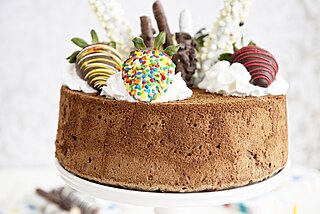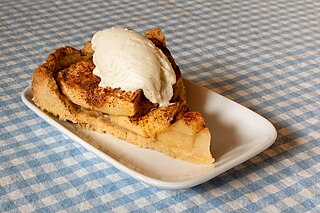
Cake is a flour confection made from flour, sugar, and other ingredients and is usually baked. In their oldest forms, cakes were modifications of bread, but cakes now cover a wide range of preparations that can be simple or elaborate and which share features with desserts such as pastries, meringues, custards, and pies.

A pancake is a flat cake, often thin and round, prepared from a starch-based batter that may contain eggs, milk and butter, and then cooked on a hot surface such as a griddle or frying pan. It is a type of batter bread. Archaeological evidence suggests that pancakes were probably eaten in prehistoric societies.

Angel food cake, or angel cake, is a type of sponge cake made with egg whites, flour, and sugar. A whipping agent, such as cream of tartar, is commonly added. It differs from other cakes because it uses no butter. Its aerated texture comes from whipped egg white. Angel food cake originated in the United States and first became popular in the late 19th century. It gained its unique reputation along with its name due to its light and fluffy texture and white color.

Dough is a thick, malleable, sometimes elastic paste made from grains or from leguminous or chestnut crops. Dough is typically made by mixing flour with a small amount of water or other liquid and sometimes includes yeast or other leavening agents, as well as ingredients such as fats or flavorings.

Pound cake is a type of cake traditionally made with a pound of each of four ingredients: flour, butter, eggs, and sugar. Pound cakes are generally baked in either a loaf pan or a Bundt mold. They are sometimes served either dusted with powdered sugar, lightly glazed, or with a coat of icing.

Devil's food cake is a moist, rich chocolate layer cake.

Icing, or frosting, is a sweet, often creamy glaze made of sugar with a liquid, such as water or milk, that is often enriched with ingredients like butter, egg whites, cream cheese, or flavorings. It is used to coat or decorate baked goods, such as cakes. When it is used between layers of cake it is known as a filling.

Shortcake generally refers to a dessert with a crumbly scone-like texture. There are multiple variations of shortcake, most of which are served with fruit and cream. One of the most popular is strawberry shortcake, which is typically served with whipped cream. Other variations common in the UK are blackberry and clotted cream shortcake and lemon berry shortcake, which is served with lemon curd in place of cream.

Apple cakes are cakes in which apples feature as a main flavour and ingredient. Such cakes incorporate apples in a variety of forms, including diced, pureed, or stewed, and can include common additions like raisins, nuts, and 'sweet' spices such as cinnamon or nutmeg. They are a common and popular dessert worldwide, thanks to millennia of apple cultivation in Asia and Europe, and their widespread introduction and propagation throughout the Americas during the Columbian Exchange and colonisation. As a result, apple desserts, including cakes, have a huge number of variations.

Chocolate cake or chocolate gâteau is a cake flavored with melted chocolate, cocoa powder, or both. It can also have other ingredients such as fudge, vanilla creme, and other sweeteners.

A génoise, also known as Genoese cake or Genovese cake, is a French sponge cake named after the city of Genoa and associated with French cuisine. It was created by François Massialot in the late 17th century. Instead of using chemical leavening, air is suspended in the batter during mixing to provide volume.

A chiffon cake is a very light cake made with vegetable oil, eggs, sugar, flour, baking powder, and flavorings. Being made with vegetable oil, instead of a traditional solid fat such as butter or shortening, it is easier to beat air into the batter.

Lane cake, also known as prize cake or Alabama Lane cake, is a bourbon-laced baked cake traditional in the American South. It was invented or popularized by Emma Rylander Lane (1856-1904), a native and long-time resident of Americus, Georgia, who developed the recipe while living in Clayton, Alabama, in the 1890s. She published the original recipe in Some Good Things to Eat (1898). Her original recipe included 8 egg whites, 1 cup butter, 1 cup sweet milk, 2 cups sifted sugar, 3 ¼ cups sifted flour, 2 teaspoons baking powder, 1 tablespoon vanilla and called for the layers to be baked in pie tins lined with ungreased brown paper rather than in cake pans. The filling called for 8 egg yolks, 1 cup of sugar, 1/2 cup butter, 1 cup seeded raisins, 1 wine-glass of whiskey or brandy, and 1 teaspoon vanilla.

Buttercream, also referred to as butter icing or butter frosting, is used for either filling, coating or decorating cakes. The main ingredients are butter and some type of sugar.

Flourless chocolate cake is a dense cake made from an aerated chocolate custard. The first documented form of the cake was seen in Ferrara, Italy, though some forms of the cake have myths surrounding their origins. The dessert contains no gluten which makes it acceptable for those with celiac disease, gluten-free diets, and during religious holidays in which gluten and grains are not permitted.

Jumbles are simple butter cookies made with a basic recipe of flour, sugar, eggs, and butter. They can be flavored with vanilla, anise, or caraway seed used for flavoring, or other flavoring can be used like almond. They were formerly often made in the form of rings or rolls.

Kürtőskalács is a spit cake specific to Hungarians from Transylvania, more specifically the Székelys. Originally popular in the Székely Land, it became popular in both Hungary and Romania. The first written record dates back to 1679 and was found in the village of Úzdiszentpéter, while the first recipe appears in a manuscript cookbook dated in 1781. Earlier a festive treat, now it is part of everyday consumption. A similar pastry to Kürtőskalács is Baumstriezel, originating in the Transylvanian Saxon communities.

Sponge cake is a light cake made with eggs, flour and sugar, sometimes leavened with baking powder. Some sponge cakes do not contain egg yolks, like angel food cake, but most of them do. Sponge cakes, leavened with beaten eggs, originated during the Renaissance, possibly in Spain. The sponge cake is thought to be one of the first non-yeasted cakes, and the earliest attested sponge cake recipe in English is found in a book by the English poet Gervase Markham, The English Huswife, Containing the Inward and Outward Virtues Which Ought to Be in a Complete Woman (1615). Still, the cake was much more like a cracker: thin and crispy. Sponge cakes became the cake recognised today when bakers started using beaten eggs as a rising agent in the mid-18th century. The Victorian creation of baking powder by English food manufacturer Alfred Bird in 1843 allowed the addition of butter to the traditional sponge recipe, resulting in the creation of the Victoria sponge. Cakes are available in many flavours and have many recipes as well. Sponge cakes have become snack cakes via the Twinkie.

The old-fashioned doughnut is a term used for a variety of cake doughnut prepared in the shape of a ring with a cracked surface and tapered edges around it. While many early cookbooks included recipes for "old-fashioned donuts" that were made with yeast, the distinctive cake doughnuts sold in doughnut shops are made with chemical leavener and may have crisper texture compared to other styles of cake doughnuts. The cracked surface is usually glazed or coated with sugar.

A banana cake is a cake prepared using banana as a primary ingredient and typical cake ingredients. It can be prepared in various manners, including as a layer cake, as muffins and as cupcakes. Steamed banana cake is found in Chinese, Malaysian, Indonesian and Vietnamese cuisine. In the Philippines, the term "banana cake" refers to banana bread introduced during the American colonial period of the Philippines.





















